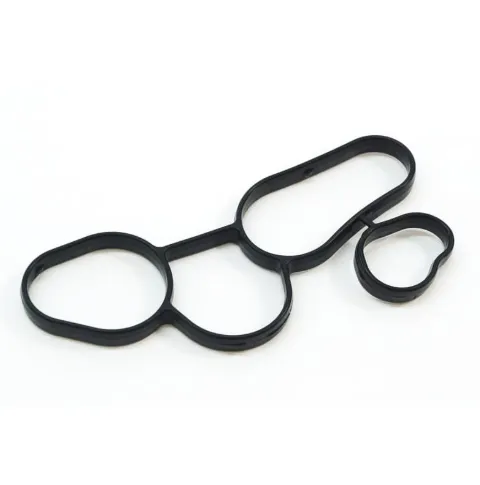Heavy-Duty Seal: A Comprehensive Guide to Diesel and Performance Oil Gaskets
When it comes to maintaining diesel engines or high-performance setups, proper sealing is critical. Gaskets such as the DT466 oil rail gasket, gasket oil cooler, and LT1 oil filter adapter gasket play essential roles in keeping oil and coolant systems leak-free and efficient. For truck enthusiasts and diesel techs, components like the oil cooler gasket 7.3, especially the oil cooler gasket 7.3 Powerstroke, are particularly vital. In this article, we’ll explore these gaskets, their purposes, and what you should know when inspecting or replacing them.

DT466 and LT1 Gaskets: High-Pressure and Performance Applications
Whether you're working on a Navistar diesel engine or a Chevy LT1, gaskets are more than just seals—they’re lifelines for oil pressure and performance.
DT466 Oil Rail Gasket
The DT466 oil rail gasket is a high-pressure seal found in Navistar’s DT466 engine series, commonly used in medium-duty trucks and buses. This gasket sits between the high-pressure oil rail and the cylinder head, sealing oil passages that feed the injectors.
Signs of a failing DT466 oil rail gasket include:
Loss of oil pressure
Hard starting, especially in cold weather
Injector performance issues
Oil leakage into the fuel system
Replacing this gasket involves removing the valve cover, oil rail, and sometimes the injectors—making it a moderately technical job that should not be ignored if performance drops or leaks appear.
LT1 Oil Filter Adapter Gasket
In the performance realm, the LT1 oil filter adapter gasket is a critical component for 90s-era GM small blocks, especially in the Corvette, Camaro, and Firebird. This gasket seals the adapter that connects the oil filter to the block and often includes oil cooler line ports.
A leaking LT1 oil filter adapter gasket can cause:
Oil leaks near the filter area
Lower-than-normal oil pressure
Messy undercarriages or engine bays
Because of its proximity to the oil filter and potential for oil loss, this gasket should be replaced any time the adapter is removed or if leaks are present.
Powerstroke Essentials: 7.3 Oil Cooler Gasket Overview
Few engines have the reputation of Ford’s 7.3L Powerstroke diesel, but like any diesel engine, its oil cooling system relies heavily on gasket integrity.
Oil Cooler 7.3 Powerstroke Gasket
The oil cooler 7.3 Powerstroke gasket seals the interface between the oil cooler assembly and the engine block. This cooler regulates engine oil temperature by running oil and coolant through a heat exchanger.
The gasket is part of a larger oil cooler assembly and usually replaced when:
There’s oil in the coolant or vice versa
You notice coolant or oil leaks near the cooler
Engine operating temps are irregular
Oil Cooler Gasket 7.3 / Oil Cooler Gasket 7.3 Powerstroke
Both the oil cooler gasket 7.3 and oil cooler gasket 7.3 Powerstroke refer to the same component—the sealing interface on either side of the oil cooler bundle. These gaskets can fail due to age, poor coolant maintenance, or thermal cycling. Common symptoms include:
Visible oil or coolant leaks under the passenger side of the engine
Coolant in the oil (milky appearance)
Overheating due to loss of coolant or blocked cooler passages
Replacement involves removing the oil cooler assembly, cleaning all mating surfaces, and installing a new gasket set with torque specifications followed precisely.
Pro tip: Always use OEM or premium aftermarket gasket kits to ensure proper sealing and durability—cheap kits often lead to rework and more leaks.
Maintenance Tips and Best Practices for Gasket Replacement
While every gasket has a unique location and function, a few general rules apply to all:
Preparation and Cleaning
Before installing any new gasket—be it a DT466 oil rail gasket or an oil cooler gasket 7.3 Powerstroke—you must thoroughly clean the mating surfaces. Use brake cleaner, plastic scrapers, and lint-free towels to ensure a clean, oil-free surface.
Torque to Specification
Over-tightening can deform gaskets, while under-tightening can cause leaks. Always use a torque wrench and follow manufacturer specs. For example, torque values for LT1 oil filter adapter gasket bolts are typically lower than you'd expect—around 18 ft-lbs.
Use Quality Replacements
Low-cost gasket sets often fail quickly. Choose gaskets from OEM sources or trusted aftermarket brands. For Powerstroke engines, Motorcraft or Mahle are safe bets.
Watch for Warning Signs
Leaks, pressure loss, or fluid mixing should always prompt an inspection. The longer a failed gasket is ignored, the more damage it can cause—not only to engine health but also to nearby components like sensors or belts.
Sealing systems in diesel and performance engines are as crucial as the fuel they run on. From the DT466 oil rail gasket ensuring injector performance to the gasket oil cooler in the 7.3 Powerstroke keeping your engine cool, every gasket serves a vital role. Even smaller components like the LT1 oil filter adapter gasket can cause major headaches if neglected.
Don’t wait for leaks to get worse—routine inspections and timely gasket replacements can keep your engine running clean, cool, and strong for the long haul.
-
Seal 12x20x5: Precision Radial Shaft Seals for Industrial Reliability
ຂ່າວ Nov.24,2025
-
Seal 12x18x5: Essential Guide to Specifications, Applications & Vendors
ຂ່າວ Nov.24,2025
-
Understanding Seal 12 20 5: Applications, Specifications & Industry Insights
ຂ່າວ Nov.23,2025
-
Durable Oil Seal 85x110x12 – Reliable Sealing Solutions for Industry
ຂ່າວ Nov.23,2025
-
Durable and Precise Oil Seal 75x95x10 for Efficient Machinery | YJM Seal
ຂ່າວ Nov.22,2025
-
Durable Oil Seal 75x100x10 for Reliable Industrial Performance | YJM Seal
ຂ່າວ Nov.22,2025
-
High-Quality Oil Seal 65x90x10 | Durable & Reliable Sealing Solutions
ຂ່າວ Nov.22,2025
ປະເພດຜະລິດຕະພັນ















